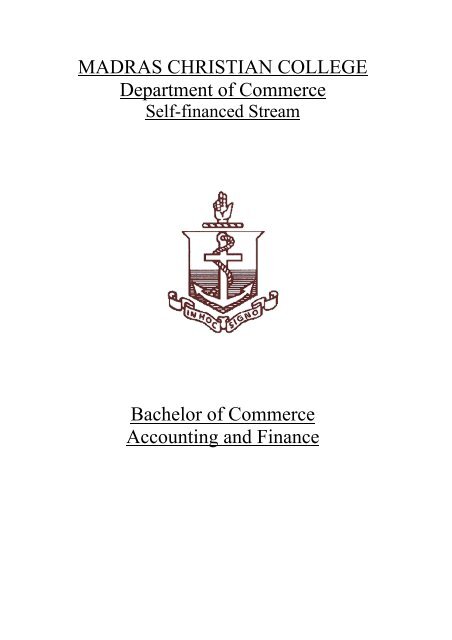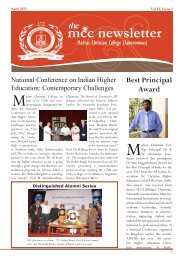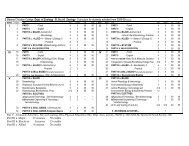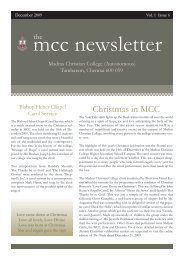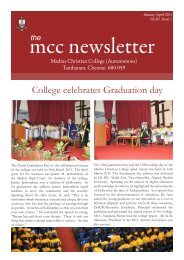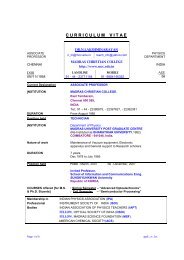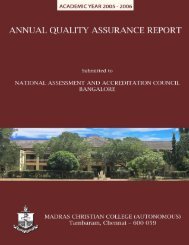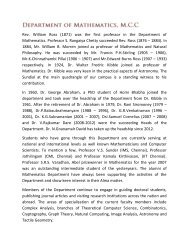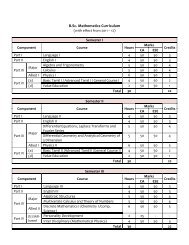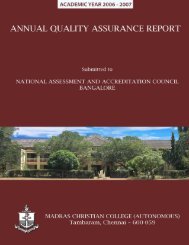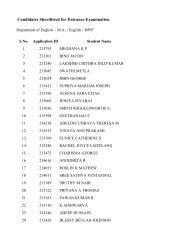B.Com-Accounting & Finance Curriculum - Madras Christian College
B.Com-Accounting & Finance Curriculum - Madras Christian College
B.Com-Accounting & Finance Curriculum - Madras Christian College
Create successful ePaper yourself
Turn your PDF publications into a flip-book with our unique Google optimized e-Paper software.
MADRAS CHRISTIAN COLLEGE<br />
Department of <strong>Com</strong>merce<br />
Self-financed Stream<br />
Bachelor of <strong>Com</strong>merce<br />
<strong>Accounting</strong> and <strong>Finance</strong>
Department of <strong>Com</strong>merce (SFS)<br />
MADRAS CHRISTIAN COLLEGE (Autonomous)<br />
BACHELOR OF COMMERCE (<strong>Accounting</strong>& <strong>Finance</strong>)<br />
CA<br />
Max.<br />
Marks<br />
ESE<br />
Max.<br />
Marks<br />
Sem Code Subjects Title of the Paper<br />
No. of<br />
Hours<br />
No. of<br />
Credits<br />
1 Part - I Language - I 4 3 50 50<br />
Part - II English - I 4 3 50 50<br />
ECAM1 Part - III Major -I Financial <strong>Accounting</strong>-I 5 5 50 50<br />
ECAM2 Part - III Major -II Business Management 5 5 50 50<br />
ECAA1 Part - III Allied -I<br />
Business Mathematics<br />
& Statistics -I 6 5 50 50<br />
ECAG<br />
Part - IV (a)<br />
General Course<br />
Fundamentals in<br />
<strong>Accounting</strong> 4 2 50 50<br />
Part - IV (d) Value education 2 1 50 50<br />
2 Part - I Language - II 4 3 50 50<br />
Part - II English - II 4 3 50 50<br />
ECAM3 Part - III Major -III Corporate <strong>Accounting</strong> - I 5 5 50 50<br />
ECAM4 Part - III Major -IV Financial <strong>Accounting</strong> - II 5 5 50 50<br />
ECAA2<br />
ECAG<br />
Part - III Allied - I<br />
Business Mathematics<br />
& Statistics - II 6 5 50 50<br />
Part - IV (a) Fundamentals in<br />
General Course <strong>Accounting</strong> 4 2 50 50<br />
Part - IV (d) Value Education 2 1 50 50<br />
3 ECAM5 Part - III Major V Capital Market 6 5 50 50<br />
ECAM6 Part - III Major VI Corporate <strong>Accounting</strong> -II 6 6 50 50<br />
ECAM7 Part – III Major VII Marketing Principles 6 5 50 50<br />
ECAA3<br />
ECAA4<br />
ECAA5<br />
Part - III Allied II<br />
(optional)<br />
Part - III Allied II<br />
(optional)<br />
Business Economics<br />
& Operations Research - I<br />
(or)<br />
Legal Aspects of Business I<br />
(or)<br />
6 5 50 50<br />
Part - III Allied II International Economics &<br />
(optional)<br />
Business - I<br />
Part - IV (b) Personality Development - I 2<br />
Part - IV (b) Inter<br />
Disciplinary<br />
Human Resource<br />
ECAAI1<br />
Management<br />
(or)<br />
ECAE1 Part - IV (c) Environmental Studies<br />
4 2 50 50
4 ECAM8 Part - III Major VIII Cost <strong>Accounting</strong> 6 6 50 50<br />
ECAM9 Part - III Major IX <strong>Accounting</strong> Package-Tally 6 5 50 50<br />
ECAM10 Part - III Major X Banking and Financial Services 6 5 50 50<br />
ECAA6<br />
Part - III Allied II<br />
(optional)<br />
Business Economics<br />
& Operations Research II<br />
(or)<br />
Part - III Allied II<br />
ECAA7 (optional)<br />
Legal Aspects of Business II<br />
6 5 50 50<br />
(or)<br />
ECAA8<br />
Part - III Allied II<br />
(optional)<br />
International Economics<br />
& Business II<br />
Part - IV (b) Personality Development - II 2 3 50 50<br />
ECAAI1<br />
Part - IV (b)<br />
Interdisciplinary Human Resource Management 4 3 50 50<br />
(or)<br />
ECAE1 Part - IV (c) Environmental Studies<br />
5 ECAM11 Part - III Major XI Management <strong>Accounting</strong> 6 5 50 50<br />
ECAM12 Part - III Major XII Research Methodology 6 5 50 50<br />
ECAM13 Part - III Major XIII Income Tax 6 5 50 50<br />
ECAM14 Part - III Major XIV Insurance 6 5 50 50<br />
ECACT1<br />
ECAGE1<br />
Part - IV (b) Skill<br />
Based <strong>Com</strong>puter<br />
Training<br />
Part - IV (b) Skill<br />
Based<br />
General Elective<br />
Introduction to<br />
Information Technology<br />
& MS Office 2 3 50 50<br />
Business <strong>Com</strong>munication<br />
(or)<br />
Entrepreneurship and Small<br />
Scale Business<br />
(or)<br />
Web Designing<br />
4 3 50 50<br />
6 ECAM15 Part - III Major XV Auditing 6 5 50 50<br />
ECAM16 Part - III Major XVI Portfolio Management 6 5 50 50<br />
ECAM17 Part - III Major XVII Financial Management 6 5 50 50<br />
ECAM18 Part - III Major XVIII Project Work 6 5 50 50<br />
ECAM19 Part - III Major XIX Internship 6 5 - 100<br />
Part – IV Extension Activities 1
FINANCIAL ACCOUNTING – I<br />
Semester – I Total hours: 75<br />
Major – I Total Credits: 5<br />
Objectives:<br />
To impart fundamental knowledge of accounting and introduce the accounting procedure applicable to various<br />
forms of organizations<br />
UNIT I<br />
Introduction to <strong>Accounting</strong>. Meaning and scope of accounting, definition of accounting – objectives of accounting<br />
– Basic accounting concepts and conventions<br />
UNIT II<br />
Single entry – Definition and salient features – Difference between single entry and double entry system –<br />
Statement of affairs – Conversion method<br />
UNIT III<br />
Royalty <strong>Accounting</strong> – Rent and Royalty – Minimum Rent – Short workings Re-coupment of short working –<br />
Surplus – Abnormal fall in output.<br />
UNIT IV<br />
Partnership Accounts – Admission – Retirement – Death of a Partner<br />
UNIT V<br />
Partnership Accounts – Dissolution of a partner – Insolvency of a partner (Garner vs. Murray) – Insolvency of all<br />
partners – Gradual realization of assets and piecemeal distribution.<br />
Books for Reference:<br />
1. S.P Jain & K.L Narang, Financial <strong>Accounting</strong> – Kalayani Publishers – 2002<br />
2. R.L Gupta & V.K Gupta, Financial <strong>Accounting</strong> – Sultan Chand Publishers – 1992<br />
3. M.C Shhukla & T.S Grewal, Advanced <strong>Accounting</strong> – Sultan Chand – 1974<br />
4. R.L Gupta & Radhaswamy, Advanced <strong>Accounting</strong> – Sultan Chand – 1972<br />
5. P. Iyengar, Advanced Accountancy, Vikas Publishing<br />
6. Basu & Das, Practice un Accountancy, Sultan Chand
BUSINESS MANAGEMENT<br />
Semester - I Total hours: 75<br />
Major – II Total Credits: 5<br />
Objectives :<br />
To provide an insight into the various functions of a manager and management practices applied in organization<br />
UNIT-I<br />
Management-Meaning –Function-Managementa science or an Art or Profession –Management and<br />
Administration – Contributions by F.W.Taylor , Henry Fayol,<br />
Elton Mayo, Peter Drucker<br />
UNIT II<br />
Planning – Importance – Process – Limitations - Types of Plans – Objectives – MBO – Policies – Procedures –<br />
Strategies – Programmes – Obstacle to Effective Planning – Forecasting – Techniques – Decision Making .<br />
UNIT III<br />
Organizing – Principles – Organisation structure – Line and Staff –Organisational charts and manuals –<br />
Delegation & Decentralization – Span of management - Authority and responsibility<br />
UNIT IV<br />
Staffing-Manpower planning – Recruitment – Sources of Recruitment – Selection - Process – Training – On the<br />
job methods – Off the job methods – Promotion .<br />
UNIT V<br />
Direction – Principles of direction – Motivation – Theories of Motivation – Maslow, Herzberg, Mc Gregor , Mc<br />
Clelland – Theory X, Theory Y, Theory Z – Leadership – Theories – Styles – <strong>Com</strong>munication – Types – Barriers<br />
– Control – Coordination.<br />
BOOKS RECOMMENDED<br />
1. Koontz&Weihrich, Essentials of Management, Mc GrawHill, 1986<br />
2. Armstrong Michael , Handbook of management techniques, Kogan Page Publishers, 2001<br />
3. S.S Chatterjee, An Introduction to Management, World Press, 1963<br />
4. Peter F. Drucker, The Practice of Management, Harper, 1954<br />
5. L.M. Prasad, Principles and Practice of Management, APH Publishers<br />
6. Hampton, Management, Mc Graw Hill, 1986<br />
7. Robbins, Management, Pearson/Prentice Hall, 2007<br />
8. Ivancevich, Management, Mc Graw Hill, 1997<br />
9. Draft, Management, Dryden Press, 2000
BUSINESS MATHEMATICS AND STATISTICS - I<br />
Semester - I Total hours: 90<br />
Allied – I Total Credits: 5<br />
Objectives:<br />
Impart sound knowledge on the application of mathematical techniques for business decision-making and logical<br />
reasoning<br />
UNIT I<br />
Algebra – Ratio- Proportion- Arithmetic Progression- Geometric Progression<br />
UNIT II<br />
Interest – Simple Interest- <strong>Com</strong>pound Interest- Discount on bills- Annuities- Annuity certain- Annuity due-<br />
Immediate Annuity- Annuity Contingent- Perpetual Annuity- Deferred Annuity- present Value<br />
UNIT III<br />
Matrix- Definition- Types of matrices- Matrix Operations- Transpose of a matrix- Inverse of a matrix- Solving<br />
simultaneous equations- matrix method- Crammer’s rule.<br />
UNIT IV<br />
Calculus: Differentiation- rules- parametric- Successive differentiation- maxima and Minima- Points of Inflexion-<br />
Application of derivatives in decision- making(excluding trigonometric functions)<br />
UNIT V<br />
Calculus: Integration- Indefinite and Definite integration- Integration by substitution- By parts- Application of<br />
Integration in decision-making (excluding trigonometric functions)<br />
BOOKS RECOMMENDED<br />
1. Sanchetti & Kapoor, Business Mathematics, K G Saur, 1979<br />
2. Draper and Klingman, Mathematical Analysis, Harper & Row, 1986<br />
3. Copper, Business Research methods, R D Irwin, 1985<br />
4. Levine, Business Statistics, Prentice Hall, 1998<br />
5. R.F.J Dewhurst, Mathematics for Accountants and Managers, Prentice Hall<br />
6. Loven Rubin, Kirk Patrik, Quantitative approaches to Management, Sultan Chand, 2004
FUNDAMENTALS IN ACCOUNTING<br />
Semester I Total hours: 60<br />
General Course I Total Credits: 2<br />
Objectives:<br />
To provide basic and essential knowledge regarding <strong>Accounting</strong><br />
UNIT I<br />
Introduction to <strong>Accounting</strong> – Meaning – <strong>Accounting</strong> concepts – Conventions<br />
UNIT II<br />
Journal – Preparation of subsidiary books- Purchase book – Sales book – Purchase return book – Sales returns<br />
book – Cash book<br />
UNIT III<br />
Ledger Posting and Preparation of Trial Balance-Meaning – Methods of preparing trial balance<br />
UNIT IV<br />
Preparation of Trading and Profit and Loss Account and Balance Sheet<br />
UNIT V<br />
Final Accounts of a <strong>Com</strong>pany-Preparation of company final accounts.<br />
BOOKS RECOMMENDED<br />
1. R.L. Gupta & Radhaswamy, Advanced Accountancy Vol.I, Sultan Chand & Sons,1999<br />
2. Jain & Narang, Financial <strong>Accounting</strong>, Kalyani Publishers,1997<br />
3. R.L.Gupta & V.K.Gupta, Financial <strong>Accounting</strong>, Sultan Chand & Sons,2006<br />
4. Larson, Financial <strong>Accounting</strong>, Irwin, 1994<br />
5. Harrison Horngen, Introduction to Financial <strong>Accounting</strong>, Pearsons higher Edication,Aug 12,1995
CORPORATE ACCOUNTING - I<br />
Semester - II Total hours: 75<br />
Major – III Total Credits: 5<br />
Objectives:<br />
Imparting a profound knowledge on accounting procedures and standards of Corporate Houses.<br />
UNIT I<br />
Issue of shares – Forfeiture and Re-issue of shares – bonus<br />
UNIT II<br />
Redemption of Preference shares – Underwriting of shares and debentures<br />
UNIT III<br />
<strong>Com</strong>pany final accounts<br />
UNIT IV<br />
Profits prior to incorporation – Valuation of Goodwill and Shares<br />
UNIT V<br />
Liquidation of <strong>Com</strong>panies – Liquidators final statement of accounts.<br />
BOOKS RECOMMENDED<br />
1. R.L Gupta and Radhaswamy, Corporate <strong>Accounting</strong>- Sultan Chand &Sons- 1972<br />
2. M.C Shukla and T.S Grewal, Corporate <strong>Accounting</strong> , Vikas Publishing House<br />
3. Jain and Narang, Corporate <strong>Accounting</strong>- Kalayani Publishers - 1997<br />
4. Chakraborthi, Corporate <strong>Accounting</strong>, Venus Pub. House
FINANCIAL ACCOUNTING II<br />
Semester – II Total hours: 75<br />
Major – IV Total Credits: 5<br />
Objectives:<br />
To impart fundamental knowledge of accounting and introduce the accounting procedure applicable to various<br />
forms of organizations<br />
UNIT I<br />
Depreciation <strong>Accounting</strong> – Meaning – Methods of Depreciation – Straight Line Method - Diminishing Balance<br />
Method – Change in the method of Depreciation.<br />
UNIT II<br />
Hire Purchase and Installment <strong>Accounting</strong>-Default and Repossession-Hire purchase trading account- Installment<br />
Purchase (Theory only)<br />
UNIT III<br />
Insurance claims account – loss of property and loss of stock-average clause- Loss of profit<br />
UNIT IV<br />
Branch Accounts – Debtors System – P&L account – Stock and Debtors System (Independent branch excluded)<br />
UNIT V<br />
Departmental accounts – Basis for allocation of expenses – Inter departmental transfer at cost or selling price –<br />
Treatment of expenses which cannot be allocated.<br />
BOOKS RECOMMENDED<br />
1. S.P Jain & K.L Narang, Financial <strong>Accounting</strong> – Kalayani Publishers – 2002<br />
2. R.L Gupta & V.K Gupta, Financial <strong>Accounting</strong> – Sultan Chand Publishers – 1992<br />
3. M.C Shukla & T.S Grewal, Advanced Accountancy – Sultan Chand – 2004<br />
4. R.L Gupta & Radhaswamy, Advanced Accountancy – Sultan Chand – 2006<br />
5. S.P Iyengar, Advanced Accountancy, Vikas Publishing<br />
6. Basu & Das, Practice in Accountancy, Sultan Chand
BUSINESS MATHEMATICS AND STATISTICS II<br />
Semester - II Total hours: 90<br />
Allied – II (<strong>Com</strong>pulsory) Total Credits: 5<br />
Objectives:<br />
To impart knowledge on the application of quantitative techniques in business decision making and other related<br />
fields<br />
UNIT I<br />
Introduction – Measures of Central Value- Mean, Median, Mode – Harmonic mean –Geometric Mean<br />
UNIT II<br />
Measures of dispersion – Range, Quartile Deviation, Mean Deviation, Standard Deviation –Variance- Coefficient<br />
of variation –Skewness – Karl Pearson and Bowleys<br />
UNIT III<br />
Correlation- Karl Pearson’s coefficient of correlation –Probable error- Standard error- Rank correlation-<br />
Concurrent Deviation - Regression analysis- Simple regression equations<br />
UNIT IV<br />
Index Numbers- Simple aggregates- Weighted Aggregates- Test of consistency of Index Numbers- Chain Base-<br />
Base Shifting-Splicing-Deflating - Family Budget<br />
UNIT V<br />
Analysis of time series- Semi average method- Moving Average method - Method of least squares<br />
Probability- Addition and Multiplication Theorems (Simple problems)<br />
BOOKS RECOMMENDED<br />
1. S.P. Gupta- Statistical Methods- S. Chand & Co. Ltd-.2003<br />
2 Pillai RSN & Bagavathi -Practical Statistics- S Chand & <strong>Com</strong>pany Ltd 2003<br />
3. Richard I. Levin&David -S. Rubin Statistics for Management Prentice Hall 2004<br />
4 S C Gupta, Indira Gupta-Business Statistics Himalaya Publishing House, 2007
CAPTIAL MARKET<br />
SEMESTER III Total hours :75<br />
Major V Total credits: 5<br />
Objectives:<br />
To introduce the concepts of financial markets and making students aware of primary and secondary markets in India<br />
and also provide insight into the regulatory framework of stock exchange.<br />
UNIT I<br />
Financial Markets- Classification of Financial markets - Capital market- Importance of capital market- Classification of<br />
capital market.<br />
UNIT II<br />
New Issues Market- Meaning – Distinctions and relationship- New Issue market and Stock exchange – Function of<br />
NIM- Instruments of Issues- Players in the NIM- Recent Trends.<br />
UNIT III<br />
Secondary market- Stock exchanges in India – Organization- Listing of securities- Group A, Group B, Group C –<br />
Listing procedure – Criteria for listing – Listing Obligations- Stock Brokers – kinds of brokers.<br />
UNIT IV<br />
Trading in stock exchanges- Methods of trading- Kinds of Transaction- Genuine Trading vs Speculative trading - Kinds<br />
of Speculators – Speculative Transactions- Recent Development.<br />
UNIT V<br />
SEBI – Objectives – Functions – Powers – (SEBI Guidelines: Primary market, Secondary Market – FII- Bonus Issues,<br />
Rights Issue, Debentures, Underwriters), Investor Protection.<br />
OTCEI – Features, Trading in OTCEI, listing on OTCEI<br />
NSE- features – BSE.<br />
BOOKS RECOMMENDED<br />
1. VA Avadhani, Capital Markets, Himalaya Publishing House,2008<br />
2. Frank J Fabozzi, Capital Markets: Institutions and Instruments,Franco Modigliani,Prentice Hall,2008<br />
3. M.Y.Khan, Financial services, Tata Mc Graw Hill<br />
4. P.Mohana Rao & R.L. Hyderabad, Financial Services,Deep&Deep Publications (P) L<br />
5. V.K.Bhalla, Management of financial services, Anmol Publications Pvt Ltd<br />
6. E.Gordon & K.Natarajan, Financial markets and services, Himalaya Publications<br />
7. Promod Mantravadi, Financial services, ICFAI Publications.
CORPORATE ACCOUNTING II<br />
Semester - III Total hours: 75<br />
Major – VI Total Credits: 6<br />
Objectives:<br />
To enable the students to understand the accounts of certain specific types of companies<br />
UNIT I<br />
Insurance <strong>Com</strong>pany Accounts – Life Insurance and General Insurance<br />
UNIT II<br />
Banking <strong>Com</strong>pany Accounts – Preparation of Profit and Loss account and Balance Sheet<br />
UNIT III<br />
Alteration of Share Capital – Internal Reconstruction.<br />
UNIT IV<br />
Amalgamation, Abortions and External Reconstruction – Purchase and Merger<br />
UNIT V<br />
Holding <strong>Com</strong>panies – Preparation of Profit and Loss account and Consolidated Balance Sheet<br />
BOOKS RECOMMENDED<br />
1. Gupta and Radhaswamy, Corporate accounting – Sultan chand & sons - 1972<br />
2. Shukla and Grewal, Advanced <strong>Accounting</strong> - Vikas Publishing house - 1996<br />
3. Jain and Narang, Corporate <strong>Accounting</strong>, Kalayani publishers - 1997<br />
4. Chakraborthi D K, Development of Corporate <strong>Accounting</strong> in India, Venus Pub House, 1994.<br />
5. S.N.Maheswari – Advanced Accountancy, Sultan Chand & Sons.
MARKETING PRINCIPLES<br />
Semester III Total Hours: 75<br />
Major VII Total Credits: 5<br />
Objectives:<br />
To acquaint the students about the marketing framework as a way of discovering and meeting consumer needs.<br />
UNIT I<br />
Marketing – Meaning – Concepts of marketing – Importance of Marketing – Marketing mix.<br />
UNIT II<br />
Market Segmentation – Basis for segmenting – Market targeting<br />
UNIT III<br />
Product – Product differentiation – Product positioning – Branding – Packaging – New Product development –<br />
Product life cycle – Distribution channels.<br />
UNIT IV<br />
Pricing – Significance of pricing – factors influencing pricing – Pricing strategies – Promotion – Types of<br />
Promotion<br />
UNIT V<br />
Online marketing – Globalization – Concepts – Impact on Indian markets.<br />
BOOKS RECOMMENDED<br />
1. Philip Kotler, Marketing Management, Prentice Hall of India Pvt Ltd, NewDelhi, 2002<br />
2. V.S.Ramaswamy and S.Namakumari, Marketing Management, Mac Millan India P Ltd, 2007<br />
3. Memoria CB & Joshi RI, Principles and Practive of Marketing, Kitab Mahal Distributors, New Delhi, 2003<br />
4. Rajan Nair.N, Marketing, Sultan Chand & Sons, New Delhi, 2006<br />
5. Walker, Management Strategy: Planning and Implementation, Tata Mcgraw Hill Pvt Ltd., New Delhi, 2004
BUSINESS ECONOMICS AND OPERATIONS RESEARCH I<br />
Semester - III Total hours: 90<br />
Allied (Optional) – II Total Credits: 5<br />
Objectives:<br />
To give a comprehensive knowledge of Demand Forecasting, Factors of production, Pricing policy and Pricing<br />
methods<br />
UNIT I<br />
Introduction- Definition – Nature – Scope of economics- Basic assumptions of economics- Usefulness of<br />
economics- Micro and macro economics<br />
UNIT II<br />
Demand Analysis- Individual & market demand- utility analysis of demand<br />
Indifference curve analysis of demand- Elasticity of demand- Demand forecasting<br />
UNIT III<br />
Factors of production- Land and its characteristics- Labour- Characteristics -Merits and Demerits – Capital –<br />
characteristics and formation – Law of returns – Production functions<br />
UNIT IV<br />
Cost and production analysis- Cost concepts and classification- Cost output relationships<br />
UNIT V<br />
Pricing decisions- Pricing under perfect competition- Pricing under imperfect competition- Pricing under Perfect<br />
competition, Monopoly, Monopolistic competition, Oligopoly, Duopoly- Kinked Demand Curve, Pricing<br />
decisions<br />
BOOKS RECOMMENDED<br />
1. Varshney & Maheswari -Managerial Economics, Sultan Chand & Sons,2003<br />
2. Habibour Rahman.-Managerial Economics, Himalaya Publishing House 2002<br />
3. Chopra O. D. -Managerial Economics, Tata Macgraw Hill publishing Co. 2004<br />
4 Samuelson P. A-Economics , Macgraw Hill-Kgakwsia Co. London, 1999
LEGAL ASPECTS OF BUSINESS - I<br />
Semester - III Total hours: 90<br />
Allied (Optional) – II Total Credits: 5<br />
Objectives:<br />
To provide an understanding of legal environment in which business is conducted<br />
UNIT – I<br />
The Indian Contract Act 1872 – Essentials of Contract – offer and Acceptance – Consideration – Capacity –<br />
Consent.<br />
UNIT – II<br />
The Indian contract Act 1872 – Performance – Discharge – Remedies for breach of contract – Quasi Contract.<br />
UNIT – III<br />
Special contracts – Contract of Bailment – Duties and Rights of Bailor and Bailee - Pledge<br />
UNIT – IV<br />
Contract of Agency- Types, Creation, duties, rights of Principal and Agent – Termination of Agency.<br />
UNIT –V<br />
Sale of Goods Act, 1930 – Sale and Agreement to sell – Conditions and Warranties – Passing of property –<br />
Performance – Remedies for breach – Rights of unpaid seller – Auction sale.<br />
Books for Reference:<br />
1. N.D. Kapoor, Mercantile Law, Sultan Chand & Sons<br />
2. M C Kuchal, Business Law, Sultan Chand Publishers<br />
3. M V Dhandapani, Business Law, Sultan Chand Publishers<br />
4. P. Saravanavel & S. Sumathi, Legal Aspects of Business, Himalaya Publishers 2004<br />
5. Bare Acts, Indian Contracts Act, Sale of Goods Act.
INTERNATIONAL ECONOMICS AND BUSINESS I<br />
Semester III Total hours : 90<br />
Allied (Optional) II Total credits : 5<br />
Objectives:<br />
To give a comprehensive idea of mechanism of international trade and its varied aspects.<br />
Unit I<br />
International Trade – Importance of International Trade, Theories of Foreign Trade: - Theories of Adam Smith,<br />
Ricardo, Habeberler’s Hechsher-ohlin.<br />
Unit II<br />
Balance of Trade, Balance of Payment – Concepts – Causes of Disequilibrium, Methods to Correct<br />
Disequilibrium – Fixed and Floating Exchange Rates – Euro – Dollar Marketing (An overview).<br />
Unit III<br />
Export Management – Export Procedure and Documents – Export <strong>Finance</strong> – Export Promotion – Export Pricing.<br />
Unit IV<br />
International Economic Organizations and its Functions<br />
IMF, IDA, IFA, ADB, UNCTAD, UNIDO.<br />
Unit V<br />
WTO and Trade Liberalization – Liberalization of Trade in Manufacturing and Agricultural Trade – TRIPS,<br />
TRIMS – Indian Patent Law.<br />
Recommended Books<br />
1. Francis Cherunilam, International Trade and Export Management – Himalaya Publishing House –<br />
Mumbai – 04.<br />
2. Paul.R.Krugman and Maurice Obstfeld, International Economics (Theory and Policy) – Pearson Education<br />
Asia – Addison Wesley Longman (P) Ltd. – Delhi -92.<br />
3. Robert J.Carbaugh, International Economics – Thomson Information Publishing Group – Wadsworth<br />
Publishing <strong>Com</strong>pany – California.<br />
4. H.G.Mannur, International Economics – Vikas Publishing House (P) Ltd – New Delhi – 14.
HUMAN RESOURCE MANAGEMENT<br />
Semester - III Total hours: 60<br />
Inter Disciplinary Total Credits: 2<br />
Elective Paper – Interdisciplinary<br />
Objective:<br />
To examine the current state of the HR practice.<br />
UNIT I<br />
Introduction – Objective – HRM in a changing environment.<br />
UNIT II<br />
Human Resource Planning – Job analysis – Job Description – Recruitment and Selection strategies – Orientation<br />
& Induction.<br />
UNIT III<br />
Job Satisfaction & Motivation – Performance appraisal system.<br />
UNIT IV<br />
Maintenance of Human resource – <strong>Com</strong>pensation – Perks & Fringe Benefits Rewards – Physical Benefits.<br />
UNIT V<br />
Quality of Work Life – Employee Welfare – Grievance Machinery – Participative management.<br />
Recommended Books<br />
1. P.C.Tripathi, Personnel Management and Industrial Relations, Sultan Chand 2004<br />
2. V S P Rao, Human Resource Management, Excel Books, 2 nd Edition<br />
3. Aswathappa, Human Resource and Personnel Management, Tata Mc Graw Hill, 3 rd Edition<br />
4. L M Prasad, Human Resource Management, Sultan Chand<br />
5. C B Gupta, Human Resource Management, Sultan Chand
COST ACCOUNTING<br />
Semester IV Total Hours: 90<br />
Major VIII Total Credits: 6<br />
Objectives:<br />
To explain elements of cost, preparation of cost sheet and techniques of costing.<br />
UNIT I<br />
Cost accounting – nature, scope and importance – Relationship of cost and financial accounting – Cost sheet –<br />
Tender – Reconciliation of cost and financial records<br />
UNIT II<br />
Elements of costs - Material – Labour and overheads – Purchases – Pricing of materials LIFO & FIFO methods –<br />
inventory control –material accounting. Labour cost – computation and control – piece rate and time rate, wages<br />
and incentive methods – Taylor, Merrick, Halsey, Rowan<br />
UNIT III<br />
Direct & indirect expenses – Overheads classification – activity based concept – allocation – apportionment of<br />
overheads, Overhead recovery rate – under and over absorption.<br />
Unit IV<br />
Unit costing – Operating costing – Job costing – Batch costing – Contract costing<br />
UNIIT V<br />
Process costing –Inter process profits – Valuation of work in progress – Normal and abnormal loss – By product<br />
and joint product accounting.<br />
Books recommended:<br />
1. S P Jain, K L Narang, Principles and practice of Cost <strong>Accounting</strong>, Kalyani Publishers, New Delhi, 2000<br />
2. S P Iyengar, Principles and practice of Cost <strong>Accounting</strong>, Sultan and Chand Sons Ltd, New Delhi, 2000<br />
3. S N Maheswari, Principles of Cost <strong>Accounting</strong>, Sultan and Chand Sons Ltd, New Delhi, 2000<br />
4. N K Prasad , Cost <strong>Accounting</strong>, Vrinda Publications (P) Ltd, New Delhi, 2000<br />
5. V K Saxena, CD Vashist, Cost <strong>Accounting</strong>, Sultan and Chand Sons Ltd, New Delhi, 2000<br />
6. M N Arora, Cost accounting- Theory and Practice, Sultan and Chand Sons Ltd, New Delhi, 2000
ACCOUNTING PACKAGE-TALLY<br />
Semester IV Total hours :75<br />
Major IX Total credits: 5<br />
Objective:<br />
To enable the students to understand the mechanized accounting structure.<br />
UNIT I<br />
Creation of <strong>Com</strong>pany, <strong>Com</strong>puterized recording of journal entry – cash and bank transactions<br />
UNIT II<br />
<strong>Com</strong>puterized recording of purchase and sale invoice, debit/credit notes delivery note, purchase order, sale order<br />
etc<br />
UNIT III<br />
<strong>Com</strong>puterized practice to prepare final accounts – trading and profit & loss account, balance sheet with minor<br />
adjustments<br />
UNIT IV<br />
<strong>Com</strong>puterized maintenance of stock records – Creation of Stock group – Stock category – Stock Item and<br />
Preparation of Stock register<br />
UNIT V<br />
<strong>Com</strong>puterized assistance to prepare bank reconciliation statement etc.,<br />
Books for reference:<br />
1. Nadhani A.K & Nadhani .K.K, Implementing Tally 6.3<br />
2. Nellai Kannan.c , Tally<br />
3. Namarata Agrawal, Financial <strong>Accounting</strong> on <strong>Com</strong>puters using Tally<br />
4. R.L. Gupta & Radhaswamy, Financial <strong>Accounting</strong>, Sultan Chand
BANKING AND FINANCIAL SERVICES<br />
Semester IV Total hours :75<br />
Major X Total credits: 5<br />
Objectives<br />
To introduce the students to banking operations and other financial services<br />
UNIT I<br />
Origin of banks-classification-definition-types of banking system- banking structure-RBI-<strong>Com</strong>mercial Banks-Cooperative<br />
banks- RRB<br />
UNIT II<br />
Private sector banks and foreign banks-role-services-credit cards-debit card-ATM-Electronic mail accounting-<br />
Tele transfer-E-Banking<br />
UNIT III<br />
Financial services- Meaning- Importance- Merchant Banking-Services of Merchant Banks-Qualities required for<br />
Merchant Bankers-Progress of Merchant Banking in India<br />
UNIT IV<br />
Hire purchase-Features-Leasing-Features-Types of lease accounts-Factoring-Functions of factor-types of<br />
factoring-Forfaiting<br />
UNIT V<br />
Mutual Fund-Concept and origin of mutual fund-Growth of mutual fund in India-Overview of Venture capital<br />
financing.<br />
BOOKS RECOMMENDED<br />
1. Sundaram, Varshney, Banking and Financial System, Sultan Chand & Sons, NewDelhi, 2004<br />
2. S.N.Maheshwari, Theory and Practice of Banking, Kalyani Publishers, 2005<br />
3. Radhaswamy, Vasudevan.S.V., A text book of banking, S.Chand & Co. Ltd, NewDelhi,2004<br />
4. M.L.Tannon, Banking Law and Practice in India, Thacker Co.Ltd, Mumbai,2004<br />
5. Hooman Estelami, Marketing Financial services, Dog ear Publishing<br />
6. Evelyn enrich & Duk Fanelli, The Financial Services Handbook, Bloomerg Press<br />
7. M.Y.Khan, Financial services, Tata Mc Graw Hill<br />
8. P.Mohana Rao & R.L. Hyderabad, Financial Services,Deep&Deep Publications (P) L<br />
9. V.K.Bhalla, Management of financial services, Anmol Publications Pvt Ltd
BUSINESS ECONOMICS AND OPERATIONS RESEARCH II<br />
Semester - IV Total hours: 90<br />
Allied Paper (Optional) – II Total Credits: 5<br />
Objectives<br />
To impart knowledge on the application of Operations Research Techniques in business decision making and<br />
other related fields<br />
UNIT I<br />
Definitions of Operations Research- Characteristics- Necessity of Operations Research in Industry- Scope-<br />
Operations Research and decision making- Difficulties in Operations Research- Limitations of Operations<br />
Research<br />
UNIT II<br />
Linear Programming- Introduction – LPP – Graphical – Simplex Method (Simple Problems only)<br />
UNIT III<br />
Game Theory: Decision Making- Conditions of certainty- Uncertainty- Two persons zero sum game with saddle<br />
point- Matrix reductions by dominance- Two Person zero sum game without saddle point- Mixed strategies-<br />
Graphical method<br />
UNIT IV<br />
Transportation- Introduction – Basic feasible solution- North West Corner Rule- Least Cost Method- VAM-<br />
Optimality Test – MODI Method<br />
UNIT V<br />
Assignment Problems<br />
BOOKS RECOMMENDED<br />
1. R. Panneerselvam,- Operations Research, PHI (2002).<br />
2 Hamdy Taha, -Operations Research – An Introduction, 7th edition PHI (2003)<br />
3 Susy Philipose,- Operations Research, Tata.Mcgraw.Hill. New Delhi.2002<br />
4 S. D. Sharma,- Operation Research, Kedarnath and Rannalt Pub.2002<br />
5 Hira and Gupta, -Operation Research, S. Chand and Co.2002<br />
6 Ackoff R. L. and M. W. Saselni,- Fundamentals of OR, Willey, New York1999
LEGAL ASPECTS OF BUSINESS - II<br />
Semester - IV Total hours: 90<br />
Allied (Optional) – II Total Credits: 5<br />
Objectives :<br />
To enable students to understand the legal environment of the corporate world.<br />
UNIT I<br />
Introduction- Nature of <strong>Com</strong>pany- <strong>Com</strong>pany Law- its History and Administration- Kinds of <strong>Com</strong>panies<br />
UNIT II<br />
Incorporation of <strong>Com</strong>pany- Memorandum of Association- Articles of Association.<br />
UNIT III<br />
Prospectus- Membership in a <strong>Com</strong>pany- <strong>Com</strong>pany Management<br />
UNIT IV<br />
Meetings and Proceedings- General Meeting- Statutory Meeting- Quorum- Minutes- proxies- Voting & Poll-<br />
Ordinary Resolution- Special Resolution- Resolutions requiring special notice.<br />
UNIT V<br />
Winding up- Meaning- Modes- Consequences of winding up- Liquidator- Duties- Power and Liabilities<br />
Books for Reference:<br />
1. N.D.Kapoor, <strong>Com</strong>pany Law, “Elements of <strong>Com</strong>pany Law”, Sultan Chand&sons ,New Delhi, Twenty<br />
eighth edition 2007<br />
2. Gogna P.P.S, “A textbook of <strong>Com</strong>pany Law”, S.Chand & <strong>Com</strong>pany Ltd; New Delhi, 2004<br />
3. Kathirevan.S, “Elements of <strong>Com</strong>pany Law”, Taxman; New Delhi<br />
4. Bare Act, “<strong>Com</strong>panies Act 1956”
INTERNATIONAL ECONOMICS AND BUSINESS II<br />
Semester - IV Total hours: 90<br />
Allied Paper (Optional) – II Total Credits: 5<br />
Objectives<br />
To give a comprehensive idea of mechanism of international trade and its varied aspects<br />
Unit I<br />
Introduction to International business – Internationalisation stages – International Business Environment –<br />
Theories of Multinational Business – Nature and working – competitive advantage – Multi National Corporations<br />
– Globalisation of World. Economy.<br />
Unit II<br />
Global Strategic management and Business ethics – Market Selection – Process – Determinant of Market<br />
Selection – Market Profile – Market Segment Selection – Market Entry Strategies.<br />
Unit III<br />
International Product Decision – New Product Development – Alternative Product Strategies – Globalisation vs.<br />
Localisation.<br />
Unit IV<br />
International Pricing – Pricing Methods/Approaches – Transfer pricing – Dumping International Logistics –<br />
Promotion Strategies.<br />
Unit V<br />
Theories of International investments – Foreign Investments – Types – Factors affecting international Investment<br />
– Foreign Direct Investment – India’s Position.<br />
BOOKS RECOMMENDED:<br />
1. Subba Rao P, Interantional Business, Himalayan Publishing House<br />
2. Cherunilam Francis, International Business, Wheeler Publishing Co.<br />
3. Philip Cateron, International Business, Toppan <strong>Com</strong>pany Ltd.
MANAGEMENT ACCOUNTING<br />
Semester - V Total hours: 90<br />
Major – XI Total Credits: 5<br />
Objectives:<br />
To emphasize how management accounting is an essential tool of management in planning, controlling and<br />
decision making.<br />
UNIT I<br />
Management accounting – Definition – Nature and Scope – Limitations – Financial statement analysis –<br />
Techniques of financial analysis – <strong>Com</strong>parative statement.<br />
UNIT II<br />
Ratio analysis – Meaning – Uses – Limitations – Classification of Ratio’s – <strong>Com</strong>putation of Ratio’s - Liquidity –<br />
Activity/ Turnover – Solvency – Profitability – Calaculation for Balance sheet.<br />
UNIT III<br />
Fund flow analysis – Meaning – Utility – Limitations – Preparation of fund flow statement – Cash flow analysis –<br />
Meaning – Utility – Limitations – Preparation of cash flow statement – Difference between cash flow and fund<br />
flow analysis.<br />
UNIT IV<br />
Cost – Volume – Profit Analysis – meaning – Break even point – Marginal Costing – Decisions involving<br />
alternative choice.<br />
UNIT V<br />
Budgetary Control – Meaning – Advantages – Limitations – Classification and types of budgets – Zero base<br />
budget.<br />
BOOKS RECOMMENDED:<br />
1. S.N. Maheswari, Management <strong>Accounting</strong>, Sultan Chand and Sons<br />
2. Khan & Jain, Management <strong>Accounting</strong>, Tata Mc Graw Hill<br />
3. N.P. Sreenivasan, , Management <strong>Accounting</strong>, Stosius Inc/Advent Books Division, 1986<br />
4. Man Mohan & S N Goyal, ,Principles of Management <strong>Accounting</strong>, Wheeler Publisher<br />
5. Saxena & Vashist, , Advanced Cost and Management <strong>Accounting</strong>, Sultan Chand & Sons, 2000
RESEARCH METHODOLOGY<br />
Semester V Total Hours: 90<br />
Major XII<br />
Total Credits:5<br />
UNIT I<br />
Research: Meaning and purpose – essentials of scientific method – limitations in social and behavioural research –<br />
types of research: explanatory, pure, applied, analytical, descriptive, historical, experimental, survey, case study<br />
UNIT II<br />
Business research design: steps in business research – selection and formulation of a research problem – review of<br />
previous research – scope of the study – setting up of objectives – definition of concepts – formulation of<br />
hypothesis and research questions – preparation of research design<br />
UNIT III<br />
Formulation of hypothesis: meaning of hypothesis – types of hypothesis – sources of hypothesis – sampling<br />
techniques: sampling theory – sampling error and data collection error – sample size – sampling methods –<br />
sample unit and sample size<br />
UNIT IV<br />
Principles and methods of collection of data: primary and secondary data-observation – interview – questionnaire<br />
– telephone interviews – construction of interview schedule and questionnaire – scales –checklist, pretest, pilot<br />
study – reliability testing and validating a questionnaire – attitude measurement – methods of scale construction –<br />
multidimensional scaling<br />
UNIT V<br />
Processing and analysis of data: tabulation- data processing through computers – report writing – types of reports<br />
– contents of a report – steps in drafting a report.<br />
BOOKS RECOMMENDED:<br />
1. William C Emory, Business Research Methods, R D Irwin Inc<br />
2. Robert G Murdrick, Business Research: Concepts and Practice, International Text Book <strong>Com</strong>pany<br />
3. Claus Moser & Graham Kalton, survey Methods in Social Investigation, Gower Publishing Co.<br />
4. David Kaplan, The Sage Hand Book of Quantitative Methodology, Sage Publications<br />
5. Anderson J Berry H D & Poole M, Thesis and Assignment Writing, Wiley Eastern Limited<br />
6. Taylor ete al. Research Methodology:A guide for researchers in management and social sciences, PHI<br />
Learning<br />
7. Uma Sekaran, Research Methods for Managers: A skill Building Approach, John Wiley and Sons.
INCOME TAX<br />
Semester V Total Hours: 90<br />
Major XIII<br />
Total Credits:5<br />
Objectives:<br />
To make the students familiar with the basic concepts of IT and enable them to learn computation of income<br />
Unit I<br />
Introduction to tax – basic concepts – residential status of individuals – agricultural income.<br />
Unit II<br />
Salary income: Definition – characteristics of salary – computation of salary income u/s17(1) – annual<br />
accretion – allowance- perquisites- profits in lieu of salary – deductions u/s 16<br />
Income from house property: meaning – annual value – deduction from annual value.<br />
Unit III<br />
Profits and gains from business and profession: computation – allowable and disallowable expenses – General<br />
deductions – principles – provisions relating to deprecation.<br />
Unit IV<br />
Captial gains: Definition of capital assets – long term and short term – transfers – cost of acquisition – cost of<br />
improvement – exempted capital gains<br />
Unit V<br />
Income from other sources – computation – grossing up – deductions and other relevant provisions.<br />
Deductions – u/s 80. 80CCC, 80D, 80DD, 80DDB, 80E, 80G, 80GG, 80GGA(theory only)<br />
BOOKS RECOMMENDED:<br />
1. Vinod Singhania, Direct Taxes and Practices, Taxman Publication, New Delhi, 2008<br />
2. Guar and Narang, Income tax Law and Practice, Kalyani Publisers,2008<br />
3. Mehrotha, Income tax Law and Accounts, Sahitiya Bhawan Publication, Agra, 2008<br />
4. T N Manoharanm Hand book on Income tax, Snowhwite publication (P) Ltd., Mumbai, 2008<br />
5. Bhagwati Prasad, Income tax Law and Practice, Wishwa Prakashan Publications, New Delhi, 2008
INSURANCE<br />
Semester V Total Hours: 90<br />
Major XIV<br />
Total Credits:5<br />
Objectives:<br />
To know the working of insurance and the role it plays in the Indian economy and explain the prospects of<br />
insurance as a career<br />
UNIT I<br />
Introduction – Historical background – Basic concepts and terminology – Types of insurance – Functions and<br />
scope of the various types of insurance – Major principles of insurance.<br />
UNIT II<br />
Insurance Market structures – Types of insurance companies – Proprietary and mutual companies – Friendly<br />
societies – Lloyd’s – <strong>Com</strong>posite companies – Specialists companies the GIC and LIC in India.<br />
UNIT III<br />
Role of the IRDA – Tax benefits pertaining to Insurance<br />
UNIT IV<br />
Insurance Products – Life Assurance Term, Whole Life Annuities and Endowment – General Insurance Products<br />
– Health Insurance – Liability Insurance including Workmen’s compensation insurance – The main products<br />
found presently in the Indian Insurance market.<br />
UNIT V<br />
Insurance as a career – Calculation of Acturaries – Adjusters – Inspectors and agents – Insurance brokers – Risk<br />
managers – Surveyors – Underwriters – Other professionals working in insurance companies.<br />
BOOKS RECOMMENDED<br />
1. Julia Hoyoakel & Bill Weiper, Insurance, All India Publishers and distributors, 2002<br />
2. Anand Ganguly, Insurance Management, Pustak Mahal Publishers, 2004<br />
3. George K Rejda, Principles of Risk Management and Insuracne, Pearson education Ltd, 2006.<br />
4. ICFAI Publications, Insurance Law and Regulation<br />
5. ICFAI Publications, Group and Health Insurance<br />
6. ICFAI Publications, Insurance Industry Emerging
INTRODUCTION TO INFORMATION TECHONOLOGY AND MS-OFFICE<br />
Semester - V Total hours: 30<br />
Skill Based <strong>Com</strong>puter Training Total Credits: 3<br />
Objective:<br />
Basic Microsoft office is covered with an emphasis on computer user skills with in windows environment in<br />
detail. Students will learn how to create web pages.<br />
UNIT I<br />
MS – WORD – Getting started with MS Word, Text Manipulations and formatting – Font, Style, size, color,<br />
bullet formatting, numbering styles, creation and usage of header and footer, method to insert graphic, working<br />
with document templates, mail merge, and mapping MS word with MS excel.<br />
UNIT II<br />
MS excel- getting started with ms excel, cell editing- copy Vs Cut and paste, using Excel Formulae and functions,<br />
file manipulations, worksheet and workbook, creation of excel graphs, excel formatting- fonts alignment, colors<br />
numbers and exploring MS Excel.<br />
UNIT III<br />
MS power point- power point task pane, toolbars and managing slides, frame movement, formatting and editing<br />
slides, insert organization chart, presentation – auto content wizard, design templates slide show.<br />
UNIT IV<br />
MS-OFFICE – Advance Concepts – Organizing Content – Sort Content in lists and tables – Perform Calculation<br />
in Tables – Modify table Formats – Managing and Delivering Presentation – Organize a presentation – Set up<br />
slide shows for delivery – Deliver Presentation<br />
UNIT V<br />
WEB PAGE Creation – HTML – Introduction – Elements – Basic Tags – Attributes – Formatting – Entities –<br />
Links – Frames – Tables – Lists – Forms – Images<br />
BOOKS RECOMMENDED<br />
1. Microsoft Office 2003, SAMS Teach Yourself by Greg Perry Pearson Education<br />
2. Microsoft Office 2003, Jennifer Ackerman Kettlel, Guy Hart-Davis, Curt Simmons, Jennifer Kettell<br />
3. HTML Black Book, Steven Holzner
BUSINESS COMMUNICATION<br />
Semester - V Total hours: 60<br />
Skill Based General Elective – I Total Credits: 3<br />
Objectives<br />
To develop the skills of a student in all dimension of communication<br />
UNIT I<br />
Basic communication model- Process of communication- Levels of communication<br />
Types of communication: Personal- Interpersonal- Intrapersonal<br />
UNIT II<br />
Public Speaking – Presentation<br />
UNIT III<br />
Business Letters- Recent trends in communication<br />
UNIT IV<br />
Interview- Group Discussion<br />
UNIT V<br />
Report writing – Objectives of a report – Kinds of Reports – Long format report – Short format report<br />
BOOKS RECOMMENDED:<br />
1. K.K. Sinha - Business <strong>Com</strong>munication Galgotia Publishing Co,2005<br />
2.R.K. Madhukar - Business <strong>Com</strong>munication & Customer relations Vikas Publishing House 2002<br />
3.Mary Munter-Business <strong>Com</strong>munication Strategy & Skill, Prentice Hall 2004<br />
4. ICMR –Business <strong>Com</strong>munication Text Book, ICMR Publications, 2007
ENTREPRENURESHIP AND SMALL SCALE BUSINESS<br />
Semester - V Total hours: 60<br />
Skill Based General Elective – I Total Credits: 3<br />
Objectives:<br />
An insight into the nature and scope of entrepreneurship and to examine the process of setting up a small scale<br />
industry<br />
UNIT I<br />
The entrepreneur – definition – characteristics of successful entrepreneur – classification of entrepreneur –<br />
entrepreneurial scene in India – case histories of successful entrepreneur<br />
UNIT II<br />
Entrepreneurial growth – role played by government and non government agencies – ESP’s, TIIC, SIDBI,<br />
PIPDIC, IDBI, IFCI, etc – problems and prospects of women entrepreneurs – rural entrepreneurs –small scale and<br />
export entrepreneurs<br />
UNIT III<br />
How to enter into market? Business ideas generation techniques – identification of business opportunities –<br />
marketing feasibility – technical – legal – managerial and locational feasibility<br />
UNIT IV<br />
Small scale industries – meaning – classification of small scale industries – significance in Indian economy –<br />
problems and possibilities of ancillary industries – sickness in small scale industries – causes and remedies .<br />
UNIT V<br />
Setting up a small scale industry – location of an enterprise – steps for starting a small industry – selection of<br />
types of organizations – incentives and subsidies – exploring export possibilities<br />
BOOKS RECOMENED:<br />
1. Vasant Desai – dynamics of entrepreneurial development and management<br />
2. Khan – management of small scale industries<br />
3. Hisrich peters – Entrepreneurship<br />
4. Vasant Desai – Management of small scale industries<br />
5. David H.Holt – Entrepreneurship new venture creation
WEB DESIGNING<br />
Semester - V Total hours: 60<br />
Skill Based General Elective – I Total Credits: 3<br />
UNIT I<br />
Introduction to the internet: networking, internet, E-Mail, resource sharing, gopher, WWW, Usenet, telnet, BBS .<br />
Internet technologies: modem, internet addressing, physical connection, telephone lines.<br />
UNIT II<br />
Internet browsers: internet explorer, Netscape navigator.<br />
Introduction to HTML: history to HTML, HTML generations, HTML documents, anchor tag, hyperlinks.<br />
UNIT III<br />
Head and body section: header section line, title, links, colorful web pages, comment lines.<br />
Designing the body section: heading printing, aligning the heading, horizontal rule, paragraph, tab settings,<br />
images and pictures<br />
UNIT IV<br />
Order and unordered list: lists, unordered lists, heading in a list, ordered lists, nested lists,.<br />
Table handling: tables, table creation, table creation in HTML, width of the tables & cells. Cell spanning multiple<br />
rows/columns, coloring cells, column specification.<br />
UNIT V:<br />
Frames: Frameset definition, frame definition, nested framesets, a web page design project.<br />
Forms: Action attribute, method attribute, enctype attribute, drop down list, sample forms<br />
REFERENCE BOOKS:<br />
1. C.Xavier. World wide Web designing with HTML, Tata McGraw hill, 2000.<br />
2. Musciano, chuck and bill Kennedy, HTML the definitive guide, Third edition, o’reily, Shroff publications<br />
and distributors private Ltd.
AUDITING<br />
Semester - VI Total hours: 90<br />
Major – XV Total Credits: 5<br />
Objectives:<br />
Enlighten the students on the various aspects of audit of business accounts.<br />
Unit I<br />
Introduction – Objects of audit – Types of audit – internal control – internal check<br />
Unit II<br />
Vouching of cash transaction, trading transactions and impersonal ledger<br />
Unit III<br />
Verification and valuation of assets and liabilities, Depreciation.<br />
Unit IV<br />
• Internal audit: Concept of internal audit – Statues on the role of internal audit – <strong>Com</strong>panies Audit<br />
(Report) Rules, Internal audit and audit committees<br />
• Tools and techniques of audit: Statistical sampling – pattern investigation- verification- physical<br />
count – flow charting – questionnaire – survey.<br />
• Execution of audit: Selection of personnel – training- routine checks- preliminary survey – testing of<br />
samples – flow charting and learning about system audited – ensuring audit trail<br />
• Documentation: Data evidencing- audit enquires – eliciting replies – discussions- empathy –<br />
finalising audit points – discussion of reports.<br />
• Reporting: Mode of reporting – level of reporting – communication and follow up<br />
• Inter personal relations in audit<br />
Unit V<br />
Auditing in depth<br />
• Management audit<br />
• Operational audit<br />
• Efficiency cum performance audit<br />
• Value for money audit<br />
• System based audit<br />
BOOKS RECOMMENDED:<br />
B.N. Tandon, Practical Audting, S>Chand <strong>Com</strong>pany Ltd., New Delhi. 2004<br />
1. Dinkar Parare, Auditing, Perason Education India, New Delhi, 2005<br />
2. Kamal K Gupta, Contemporary Auditing, Tata McGraw Hill Publications Ltd., 2005<br />
3. T R Sharma, Auditing, Sahitya Bhawan Publications, New Delhi, 2004
PORTFOLIO MANAGEMENT<br />
Semester - VI Total hours: 90<br />
Major – XVI Total Credits: 5<br />
Objectives:<br />
To introduce the concepts of service marketing, explain how service features result in certain unique problems in<br />
marketing and provide an insight into the marketing strategies.<br />
UNIT I<br />
Investment Management-Introduction – Selection of Investments – Classification of Securities – Risk and<br />
uncertainty – Types of risks – Risk and Expected Return – Measurement of Portfolio risk –Benefits of<br />
Diversification – Investment Strategies – Types of <strong>Com</strong>panies and Stocks –<br />
Matrix approach in investment decisions<br />
UNIT II<br />
Security Analysis-Introduction – Technical approach – Dow Theory – Advance Decline Theory – Chartism –<br />
Assumptions of Technical Analysis Economic and Industry Analysis<br />
UNIT III<br />
Modern Portfolio Theory -Mean – Variance Model – Capital Market Line – Market Portfolio – Capital Asset<br />
Pricing<br />
Model – Security Market line – Beta factor – Alpha and Beta Coefficient – Arbitrage<br />
Pricing Model<br />
UNIT IV<br />
Fundamental Approach-Return on Investment – P/E Ratio – Earning Per Share – Book Value – Debt-Equity<br />
Ratio-Dividend payout ratio – Dividend Yield – Dividend Cover – Interest Cover<br />
UNIT V<br />
Stock Market and Derivatives-Capital Market – Derivative Market – <strong>Com</strong>modity Derivatives – Depository<br />
Operations<br />
BOOKS RECOMMENDED:<br />
1. Security Analysis and Portfolio Management, V Gangadhar, Anmol Publications 2003.<br />
2. Security Analysis and Portfolio Management, Donald E Fisher, Prentice Hall, 2005<br />
3. Investment Analysis and Portfolio Management, Chandra P 2008<br />
4. Security Analysis and Portfolio Management, V A Avadhani, Himalaya Publshing, 2008
FINANCIAL MANAGEMENT<br />
Semester - VI Total hours: 90<br />
Major – XVII Total Credits: 5<br />
Objectives:<br />
To explain how finance constitutes the core of any company and emphasize on management of funds such as<br />
raising funds, allocating them and the risk involved it.<br />
Unit I<br />
Nature and scope – profit maxmisation vs. Wealth maximization – importance of financial management –<br />
Time value of money (Theory only)<br />
Unit II<br />
Capital structure – meaning – optimum capital structure – factors affecting capital structure – sources of<br />
finance – Leverages- meaning – types – significance (Problems)<br />
Unit<br />
III<br />
Cost of capital – concept – importance- classification - determination of cost of capital (Problems)<br />
Unit IV<br />
Working capital management – meaning- factors- types- sources of working capital – management of cash,<br />
inventories, accounts receivables, accounts payable (Problems)<br />
Unit V<br />
Capital budgeting – importance – capital budgeting methods (Problems)<br />
BOOKS RECOMMENDED:<br />
1. S N Maheswari, Financial Management – principle and practice, Sultan and chand Sons, New Delhi,<br />
2004<br />
2. Prasanna Chandra, Financial Management ; Theory and practice, Tata McGraw Hills, 2004<br />
3. I M Pandey, Financial Management, Vikas Publications Pvt. Ltd., New Delhi, 2002<br />
4. James C, Van Horne, Fundamentals of Financial management, Prentice Hall of India (P) Ltd, 2002<br />
5. P V Kulkarni, Financial Management, Himalaya Publication House, Dehradun, 2000<br />
Problems 70%, Theory 30%.
PROJECT WORK<br />
Semester - VI Total hours: 90<br />
Major – XVIII Total Credits: 5<br />
A Student should select a topic for the project work in the fifth semester itself and submit report at the end<br />
of the sixth semester. Viva Voce would be conducted for the project work. The guide and the external examiner<br />
shall evaluate the project report and conduct the Viva. The project work shall be related to <strong>Com</strong>merce.<br />
Assessment:<br />
• The project report will be assessed for 80 marks.<br />
• There will be external Viva Voce for 20 marks.<br />
• The total marks for the project will be 100 and the credit awarded will be 5.<br />
INTERNSHIP<br />
Semester : VI<br />
Major : XIX<br />
Duration : 1Month
Objectives:<br />
To enable the student to apply the skills they have learnt theoretically in the major papers.<br />
To provide vocational guidance to select the job situation from among the alternatives that would maximize<br />
his/her potentialities to the fullest and allow the student to function effectively and satisfactorily.<br />
Methodology:<br />
Internship is an integral part of the graduate programme. It consists of practicing skills under the guidance of<br />
professional in selected fields. Such training provides and opportunity for the learner to apply theory into practice<br />
and gain first hand experience. Therefore field practicum in semester VI is compulsory and a student should have<br />
100 percent attendance. Each student should submit a field work report at the end of every week to the concerned<br />
staff and appraisal by the supervisor is expected to be handed over to the staff on completion of the programme.<br />
Assessment:<br />
• There will be external viva voce before the commencement of the semester examination and the assessment<br />
will be for 100 marks. Report carries 75 and viva 25.<br />
The Internship will be evaluated under the following criteria:<br />
1) Practical Knowledge<br />
2) Skills<br />
3) Attitude<br />
4) Methods Practiced<br />
5) Programmes Implemented<br />
• The total marks for the training programme will be 100 and the credit allotted will be 5.
LIST OF GENERAL ELECTIVES<br />
1. Business <strong>Com</strong>munication<br />
2. Entrepreneurial Development and Small Scale Industries<br />
3. Web Applications<br />
4. Human Resource Development
BUSINESS COMMUNICATION<br />
Semester - V Total hours: 60<br />
Skill Based General Elective – I Total Credits: 3<br />
Objectives<br />
To develop the skills of a student in all dimension of communication<br />
UNIT I<br />
Basic communication model- Process of communication- Levels of communication<br />
Types of communication: Personal- Interpersonal- Intrapersonal<br />
UNIT II<br />
Public Speaking – Presentation<br />
UNIT III<br />
Business Letters- Recent trends in communication<br />
UNIT IV<br />
Interview- Group Discussion<br />
UNIT V<br />
Report writing – Objectives of a report – Kinds of Reports – Long format report – Short format report<br />
BOOKS RECOMMENDED:<br />
1. K.K. Sinha - Business <strong>Com</strong>munication Galgotia Publishing Co,2005<br />
2.R.K. Madhukar - Business <strong>Com</strong>munication & Customer relations Vikas Publishing House 2002<br />
3.Mary Munter-Business <strong>Com</strong>munication Strategy & Skill, Prentice Hall 2004<br />
4. ICMR –Business <strong>Com</strong>munication Text Book, ICMR Publications, 2007
ENTREPRENURESHIP AND SMALL SCALE BUSINESS<br />
Semester - V Total hours: 60<br />
Skill Based General Elective – I Total Credits: 3<br />
Objectives:<br />
An insight into the nature and scope of entrepreneurship and to examine the process of setting up a small scale<br />
industry<br />
UNIT I<br />
The entrepreneur – definition – characteristics of successful entrepreneur – classification of entrepreneur –<br />
entrepreneurial scene in India – case histories of successful entrepreneur<br />
UNIT II<br />
Entrepreneurial growth – role played by government and non government agencies – ESP’s, TIIC, SIDBI,<br />
PIPDIC, IDBI, IFCI, etc – problems and prospects of women entrepreneurs – rural entrepreneurs –small scale and<br />
export entrepreneurs<br />
UNIT III<br />
How to enter into market? Business ideas generation techniques – identification of business opportunities –<br />
marketing feasibility – technical – legal – managerial and locational feasibility<br />
UNIT IV<br />
Small scale industries – meaning – classification of small scale industries – significance in Indian economy –<br />
problems and possibilities of ancillary industries – sickness in small scale industries – causes and remedies .<br />
UNIT V<br />
Setting up a small scale industry – location of an enterprise – steps for starting a small industry – selection of<br />
types of organizations – incentives and subsidies – exploring export possibilities<br />
BOOKS RECOMENED:<br />
6. Vasant Desai – dynamics of entrepreneurial development and management<br />
7. Khan – management of small scale industries<br />
8. Hisrich peters – Entrepreneurship<br />
9. Vasant Desai – Management of small scale industries<br />
10. David H.Holt – Entrepreneurship new venture creation
WEB DESIGNING<br />
Semester - V Total hours: 60<br />
Skill Based General Elective – I Total Credits: 3<br />
UNIT I<br />
Introduction to the internet: networking, internet, E-Mail, resource sharing, gopher, WWW, Usenet, telnet, BBS .<br />
Internet technologies: modem, internet addressing, physical connection, telephone lines.<br />
UNIT II<br />
Internet browsers: internet explorer, Netscape navigator.<br />
Introduction to HTML: history to HTML, HTML generations, HTML documents, anchor tag, hyperlinks.<br />
UNIT III<br />
Head and body section: header section line, title, links, colorful web pages, comment lines.<br />
Designing the body section: heading printing, aligning the heading, horizontal rule, paragraph, tab settings,<br />
images and pictures<br />
UNIT IV<br />
Order and unordered list: lists, unordered lists, heading in a list, ordered lists, nested lists,.<br />
Table handling: tables, table creation, table creation in HTML, width of the tables & cells. Cell spanning multiple<br />
rows/columns, coloring cells, column specification.<br />
UNIT V:<br />
Frames: Frameset definition, frame definition, nested framesets, a web page design project.<br />
Forms: Action attribute, method attribute, enctype attribute, drop down list, sample forms<br />
REFERENCE BOOKS:<br />
1. C.Xavier. World wide Web designing with HTML, Tata McGraw hill, 2000.<br />
2. Musciano, chuck and bill Kennedy, HTML the definitive guide, Third edition, o’reily, Shroff publications<br />
and distributors private Ltd.
HUMAN RESOURCE DEVELOPMENT<br />
Semester - V Total hours: 60<br />
Skill Based General Elective – I Total Credits: 3<br />
Objectives:<br />
• To orient the students to the field of HRD<br />
• To help the students identify the various resources in human beings<br />
• To help the students design HRD programmes<br />
UNIT I<br />
HRD – Concept, features, significance, scope, objectives and need for HRD<br />
UNIT II<br />
HRD framework, techniques of HRD, functions of HRD Manager<br />
UNIT III<br />
Basic understanding of HRM, Training and Development, Trainer, Mentor, Facilitator and Resource Developer<br />
UNIT IV<br />
The making of HRD Facilitator – identifying, developing, mobilizing and managing human resources, values,<br />
interests, skills, emotions and feelings, experience and body system.<br />
UNIT V:<br />
Designing HRD programme for leadership, communication, self discovery, team work, personal and<br />
organizational effectiveness.<br />
REFERENCE BOOKS:<br />
1. Nair M R R, Excellence through Human Resource Development, Rao T V (ed)<br />
2. Subba Rao P, Personnel and Human Resource Management, Text & Cases<br />
3. Vanita, Effective <strong>Com</strong>munication in Human Resource Development


